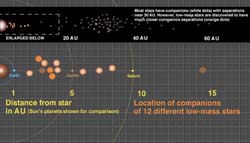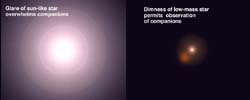
| This discovery image from the Gemini Observatory represents the closest brown dwarf companion ever directly imaged around a star (named LHS 2397a). This image was obtained on Feb. 7, 2002 with the Gemini North Telescope on Mauna Kea in Hawaii using the University of Hawaii's Adaptive Optics system Hokupa`a and the QUIRC infrared imager. The resolution of the image is 0.1 arcseconds (equal to the size of a quarter held 32 miles away). The companion is so faint and red that it must have a cool "L7" atmosphere and is therefore only massive enough to be a brown dwarf.
Credit: " Gemini Observatory/Melanie Freed, Laird Close, Nick Siegler University of Arizona/ Hokupa'a-QUIRC image, University of Hawaii, IfA" |
|
 |
Companion Distances From Low-Mass Stars: This illustration shows the relatively small separations of the 12 companions found around low-mass stars that were studied in the Gemini Observatory survey by Laird Close et al. The wide view at the top shows the common distances for companions around larger "parent" stars (white dots), with the low-mass companions (orange dots) enlarged in the lower part of the illustration and a scale of our solar system drawn in for comparison. The fainter orange companions are brown dwarfs; the brightest are likely low-mass stars. Two gridlines equals one Astronomical Unit or the average distance between the Earth and the Sun (approximately 150,000,000 km or 93,000,000 miles.) Credit: "Gemini Observatory" optional additional credit "Artwork by Jon Lomberg" |
 |
A Glaring Problem: The main difficulty in detecting smaller bodies in orbit around stars is the central star is often so bright that its glare hides the dim light from the much fainter companion. By focusing on low-mass central stars, this study was able to detect much closer and smaller companions due to the reduced glare from the central star as illustrated in this diagram. This problem of faint companion detection around a bright star is often described as like "trying to see a firefly near a spotlight". Credit: "Gemini Observatory" optional additional credit "Artwork by Jon Lomberg" |
|
|
What Orbits Stars: Astronomers have found many types of objects in orbit around stars. These range from other full-sized stars like our sun (binary star systems) to Jupiter sized planets (never directly imaged but inferred from radial-velocity spectroscopy). The relative sizes of these various types of bodies are shown above for comparison. Even though a brown dwarf can be similar in diameter to a Jupiter sized planet, brown dwarfs are 13-75 times more massive and they can appear on the order of 100-1,000,000 times brighter than a Jupiter sized planet at infrared wavelengths where they are studied with telescopes. Credit: "Gemini Observatory" optional additional credit "Artwork by Jon Lomberg" |